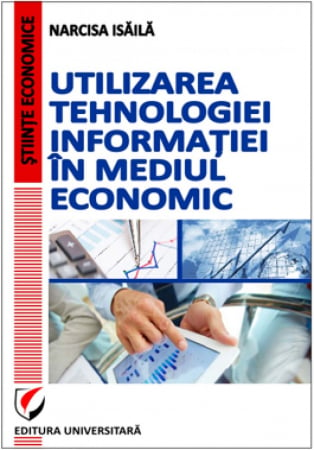Manuscript proposals: [email protected] / 0745 204 115 //// Tracking orders Individuals / Sales: 0745 200 357 / Orders Legal entities: 0721 722 783
ISBN: 978-973-749-858-8
DOI: 10.5682/9789737498588
Publisher year: 2014
Edition: III
Pages: 196
Publisher: Editura Universitară
Author: Mihai Diaconescu
Product Code:
9789737498588
Do you need help?
0745 200 357
- Description
- Download (1)
- Authors
- Content
- More details
- Reviews (0)
Marketing is not just a function of the company, it is its spirit. It shows us what goods to produce, what services to provide, what price level to practice, where and when to advertise, what to communicate to our customers and how to do it. Marketing is the engine that leads the company to success.
The success of a marketing company focuses on making the most of the information, analysis and problem-solving capabilities it faces.
The paper includes grid tests and tries to answer these questions that may be of concern to students, researchers, workers in the field or other categories of specialists.
The success of a marketing company focuses on making the most of the information, analysis and problem-solving capabilities it faces.
The paper includes grid tests and tries to answer these questions that may be of concern to students, researchers, workers in the field or other categories of specialists.
-
Marketing
Download
MIHAI DIACONESCU
Associate Professor PhD at the Bucharest Academy of Economic Studies, Faculty of Marketing, Department of Marketing
Graduate of the Faculty of Commerce, Bucharest Academy of Economic Studies
Since 1993 teacher at the Marketing Department of the Bucharest Academy of Economic Studies
Graduate of the courses "Entrepreneurship and market economy", organized by the International Center for Entrepreneurial Studies (1991)
Graduate of the specialization courses in "Business Economics and Consumer Behavior" organized by the "Luigi Bocconi" University of Milan (Italy)
International specializations in marketing in the University of Social Sciences in Toulouse (France) and at the University of Neuchatel (Switzerland)
Doctor in economics since 1999
Author and co-author of 12 books in the field
Author and co-author of over 45 studies and research papers, scientific communications and articles in the field of marketing
Associate Professor PhD at the Bucharest Academy of Economic Studies, Faculty of Marketing, Department of Marketing
Graduate of the Faculty of Commerce, Bucharest Academy of Economic Studies
Since 1993 teacher at the Marketing Department of the Bucharest Academy of Economic Studies
Graduate of the courses "Entrepreneurship and market economy", organized by the International Center for Entrepreneurial Studies (1991)
Graduate of the specialization courses in "Business Economics and Consumer Behavior" organized by the "Luigi Bocconi" University of Milan (Italy)
International specializations in marketing in the University of Social Sciences in Toulouse (France) and at the University of Neuchatel (Switzerland)
Doctor in economics since 1999
Author and co-author of 12 books in the field
Author and co-author of over 45 studies and research papers, scientific communications and articles in the field of marketing
FOREWORD / 9
CHAPTER 1
FUNDAMENTALS OF MARKETING / 11
1.1. The emergence of marketing / 11
1.2. Defining marketing / 12
1.3. Marketing functions / 12
CHAPTER 2
THE EXTERNAL ENVIRONMENT OF THE ENTERPRISE / 15
2.1. External microenvironment of the enterprise / 16
2.2. External macro - environment of the enterprise / 20
2.3. Typology of the external environment of the enterprise / 28
CHAPTER 3
ENTERPRISE MARKET / 30
3.1. Potential market, effective market and target market / 33
3.2. Competition - the main disruptive factor of the enterprise market / 35
3.3. Coordinates of competition policy in the European Union / 42
3.4. Coordinates for the analysis of the market evolution / 49
3.5. Ways of developing (expanding) the enterprise market / 52
3.6. Market investigation and marketing information / 53
3.6.1. Sources of information / 54
3.6.2. Methods of obtaining marketing information / 55
3.6.3. Information structuring / 57
CHAPTER 4
ENTERPRISE MARKETING POLICY / 62
4.1. Market strategy / 62
4.1.1. The mission and objectives of the enterprise / 63
4.1.2. The place of the market strategy in the marketing activity / 64
4.1.3. Substantiation of the market strategy / 66
4.1.4. Typology of market strategies / 68
4.2. Marketing mix / 73
CHAPTER 5
PRODUCT POLICY / 76
5.1. Conceptual definition of the product / 76
5.2. Packaging - the body component of the product / 77
5.3. Current product quality issues / 84
5.4. Standardization and certification in the field of products / 84
5.5. Product quality guarantee / 89
5.6. Product positioning on the market / 90
5.7. New product development / 92
5.8. Stimulating factors for the development of new products / 94
5.9. The process of creating new products / 96
5.10. Strategies for renewing the product offer at the enterprise level / 101
CHAPTER 6
PRICE POLICY / 104
6.1. Price limits / 104
6.2. Price-quality ratio / 105
6.3. Intervention techniques in price formation / 105
6.4. Price policy objectives / 106
6.5. Pricing strategies / 107
6.6. Price regulations / 114
6.7. Pricing for a range of products / 116
6.8. Price mobility / 117
6.9. Tactics for adjusting prices to inflation / 117
6.10. Contract price / 119
CHAPTER 7
DISTRIBUTION POLICY / 124
7.1. Distribution content / 124
7.2. The role of distribution / 125
7.3. Distribution functions / 126
7.4. Place of distribution in the marketing mix / 128
7.5. Distribution channels / 128
7.6. Wholesale intermediaries / 133
7.7. Retail intermediaries / 135
7.8. Distribution strategies / 136
7.9. Organization and management of sales forces / 138
CHAPTER 8
COMMUNICATION POLICY / 145
8.1. Communication target profile / 145
8.2. The structure of the communication activity / 146
8.3. Advertising / 146
8.4. Use of distinctive signs and messages regarding quality / 149
8.5. Sales promotion / 154
8.6. Public relations / 155
8.7. Communication strategies in the case of organic products / 158
CHAPTER 9
MARKETING PROGRAM - TOOL FOR COORDINATION, SYNCHRONIZATION AND OPTIMIZATION OF ENTERPRISE EFFORTS / 160
9.1. The stages of elaborating the marketing program / 160
9.2. Case study: ARPECHIM / 161
Launch on the Romanian market of multigrade car oil / 161
„ARPECHIM M20W / 40 super 2- hc” / 161
GRID TESTS / 188
BIBLIOGRAPHY / 194
CHAPTER 1
FUNDAMENTALS OF MARKETING / 11
1.1. The emergence of marketing / 11
1.2. Defining marketing / 12
1.3. Marketing functions / 12
CHAPTER 2
THE EXTERNAL ENVIRONMENT OF THE ENTERPRISE / 15
2.1. External microenvironment of the enterprise / 16
2.2. External macro - environment of the enterprise / 20
2.3. Typology of the external environment of the enterprise / 28
CHAPTER 3
ENTERPRISE MARKET / 30
3.1. Potential market, effective market and target market / 33
3.2. Competition - the main disruptive factor of the enterprise market / 35
3.3. Coordinates of competition policy in the European Union / 42
3.4. Coordinates for the analysis of the market evolution / 49
3.5. Ways of developing (expanding) the enterprise market / 52
3.6. Market investigation and marketing information / 53
3.6.1. Sources of information / 54
3.6.2. Methods of obtaining marketing information / 55
3.6.3. Information structuring / 57
CHAPTER 4
ENTERPRISE MARKETING POLICY / 62
4.1. Market strategy / 62
4.1.1. The mission and objectives of the enterprise / 63
4.1.2. The place of the market strategy in the marketing activity / 64
4.1.3. Substantiation of the market strategy / 66
4.1.4. Typology of market strategies / 68
4.2. Marketing mix / 73
CHAPTER 5
PRODUCT POLICY / 76
5.1. Conceptual definition of the product / 76
5.2. Packaging - the body component of the product / 77
5.3. Current product quality issues / 84
5.4. Standardization and certification in the field of products / 84
5.5. Product quality guarantee / 89
5.6. Product positioning on the market / 90
5.7. New product development / 92
5.8. Stimulating factors for the development of new products / 94
5.9. The process of creating new products / 96
5.10. Strategies for renewing the product offer at the enterprise level / 101
CHAPTER 6
PRICE POLICY / 104
6.1. Price limits / 104
6.2. Price-quality ratio / 105
6.3. Intervention techniques in price formation / 105
6.4. Price policy objectives / 106
6.5. Pricing strategies / 107
6.6. Price regulations / 114
6.7. Pricing for a range of products / 116
6.8. Price mobility / 117
6.9. Tactics for adjusting prices to inflation / 117
6.10. Contract price / 119
CHAPTER 7
DISTRIBUTION POLICY / 124
7.1. Distribution content / 124
7.2. The role of distribution / 125
7.3. Distribution functions / 126
7.4. Place of distribution in the marketing mix / 128
7.5. Distribution channels / 128
7.6. Wholesale intermediaries / 133
7.7. Retail intermediaries / 135
7.8. Distribution strategies / 136
7.9. Organization and management of sales forces / 138
CHAPTER 8
COMMUNICATION POLICY / 145
8.1. Communication target profile / 145
8.2. The structure of the communication activity / 146
8.3. Advertising / 146
8.4. Use of distinctive signs and messages regarding quality / 149
8.5. Sales promotion / 154
8.6. Public relations / 155
8.7. Communication strategies in the case of organic products / 158
CHAPTER 9
MARKETING PROGRAM - TOOL FOR COORDINATION, SYNCHRONIZATION AND OPTIMIZATION OF ENTERPRISE EFFORTS / 160
9.1. The stages of elaborating the marketing program / 160
9.2. Case study: ARPECHIM / 161
Launch on the Romanian market of multigrade car oil / 161
„ARPECHIM M20W / 40 super 2- hc” / 161
GRID TESTS / 188
BIBLIOGRAPHY / 194
Marketing is not just a function of the company, it is its spirit. He shows us what goods to produce, how much and until what date; what services to provide; what price level to practice, what discounts to offer; where and when to advertise, what to communicate to our clients and how to do it. Marketing is the engine that leads the company to success.
In the current period, more and more companies are forced to radically redefine their objectives and strategies for action on the market. From where, previously, they operated in the conditions of a competition and stable or well-known clients, nowadays the companies operate in a dynamic environment, on which the technological progress has left its mark significantly, in which rapid changes take place at the level of the competition. a continuous decrease in customer loyalty and the emergence of new regulations.
The most successful companies are those that manage to offer customers the expected satisfaction, understanding marketing not as a separate function, but as a philosophy to be mastered throughout the organization. What is required of the marketing department is to identify the consumer segments, the desires, preferences and aspirations that the company can profitably satisfy, as well as the ways in which they can be achieved with higher efficiency compared to other competitors.
A successful company must be considered a system designed to ensure the development of internal business processes and not just a set of compartments. It must create a culture in which all employees gain awareness of the market and the product.
As a discipline, marketing reviews its premises, concepts, methodology and operating systems in order to make the most appropriate decisions in business. Those who work in this field must know when to choose to approach a market in a global sense or only for a segment of it, when to launch new products or just to expand the range of existing ones, when to encourage and when to stop distributing a product. , when to diversify the advantages of the offer or to reduce the price, when to increase or reduce the budget for sales, advertising or other elements specific to the marketing activity.
This book was built according to such coordinates and tries to answer questions that may be of concern to students, researchers, workers in the field or other categories of specialists.
The creation of this book is the result of several years of study and documentation in the country, but also in universities in France, Italy and Switzerland. In this way I would like to address my thanks to the team of professors from the Marketing Department within the Academy of Economic Studies - Bucharest for the permanent encouragement and support given in carrying out this work.
The Author
In the current period, more and more companies are forced to radically redefine their objectives and strategies for action on the market. From where, previously, they operated in the conditions of a competition and stable or well-known clients, nowadays the companies operate in a dynamic environment, on which the technological progress has left its mark significantly, in which rapid changes take place at the level of the competition. a continuous decrease in customer loyalty and the emergence of new regulations.
The most successful companies are those that manage to offer customers the expected satisfaction, understanding marketing not as a separate function, but as a philosophy to be mastered throughout the organization. What is required of the marketing department is to identify the consumer segments, the desires, preferences and aspirations that the company can profitably satisfy, as well as the ways in which they can be achieved with higher efficiency compared to other competitors.
A successful company must be considered a system designed to ensure the development of internal business processes and not just a set of compartments. It must create a culture in which all employees gain awareness of the market and the product.
As a discipline, marketing reviews its premises, concepts, methodology and operating systems in order to make the most appropriate decisions in business. Those who work in this field must know when to choose to approach a market in a global sense or only for a segment of it, when to launch new products or just to expand the range of existing ones, when to encourage and when to stop distributing a product. , when to diversify the advantages of the offer or to reduce the price, when to increase or reduce the budget for sales, advertising or other elements specific to the marketing activity.
This book was built according to such coordinates and tries to answer questions that may be of concern to students, researchers, workers in the field or other categories of specialists.
The creation of this book is the result of several years of study and documentation in the country, but also in universities in France, Italy and Switzerland. In this way I would like to address my thanks to the team of professors from the Marketing Department within the Academy of Economic Studies - Bucharest for the permanent encouragement and support given in carrying out this work.
The Author
If you want to express your opinion about this product you can add a review.
write a review

6359.png)
![Marketing [1] Marketing [1]](https://gomagcdn.ro/domains/editurauniversitara.ro/files/product/large/marketing-1117-337477.jpg)














